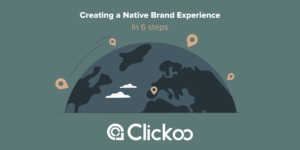
What is a native brand experience?
In a nutshell, a native brand experience is about positioning your brand so it effectively appears to be a business local to the country your audience is in. There are many benefits to this approach, but the crux of the matter is that it gives users and a better experience, and ultimately helps to grow your brand more effectively in your new market.
Why it’s important
You may be well established in your current market, but chances are you’re the new-comer in your latest international market. Being a new entrant presents it’s own set of unique challenges for your brand, each hurdle made ever more difficult to overcome if your target audience doesn’t respond to your advertising call to actions, or struggles to understand your live chat service representatives. Ultimately, how effectively you tailor your brand experience to new markets can be make or break for your expansion into that market.
So, what are the key steps to creating a native brand experience for your international audiences? Here are 6 quick takeaways to ensure you’re making the most of your international marketing.
1) Get to know your audience
If you want to resonate with your target market, then you’re going to need to get to know them inside out. By this, we mean more than just their demographic factors. Whilst the likes of age, location and education are your starting point, you’ll need to dig a lot deeper.
2) Market discovery
Equally important is your audience’s surroundings – that is, the broader market that they’re in.
Performing a PESTLE analysis is always a good idea if you want to create a seamless brand experience in your new market.
This knowledge will help you to really tailor the experience to the unique expectations and environment of your new audience.
3) Understand their technology
Given how much advertising relies on technology these days, it’s a vital element when shaping your native brand experience. There are many different ways in which your audience can differ without you even realising. After all, lots of assumptions are made when it comes to the way people interact with the digital world, but it’s not the same for everyone.
4) Map the journey
Technology plays a key role in the customer journey too, and understanding where your audience is along it can ensure you target them without issue. The ‘marketing funnel’ will help here. Whilst there are a few versions of this framework out there, the AIDA model is among one of the most commonly used:
Stage 1: Awareness
Stage 2: Interest
Stage 3: Desire
Stage 4: Action
5) Localise your marketing
When expanding your brand internationally, it is essential to ensure that you are taking a localised approach to your marketing.
Targeting audiences with non-native creative or ad copy will have a negative effect on your campaigns. When running digital marketing campaigns, a lot of the time an ad will link through to directly to a landing page or a web page. These will need to be localised too.
6) Get everyone onboard
Lastly, to implement a successful native brand experience, you’ll need to make sure that it’s not just up to the person overseeing it – they need support.
There’s the obvious team members, of course, like your designers and copywriters. But as every touchpoint needs to be localised, you need to involve any staff members that deal with those touchpoints. Remember the aim here is to create the illusion that your brand is native to the targeted country, so each small detail and point of interaction matters.
This article serves as an introduction to the 6 key elements of creating a native brand experience. If you’d like to learn more about the process then download our free guide below!
Please fill in the form below to receive your guide.


